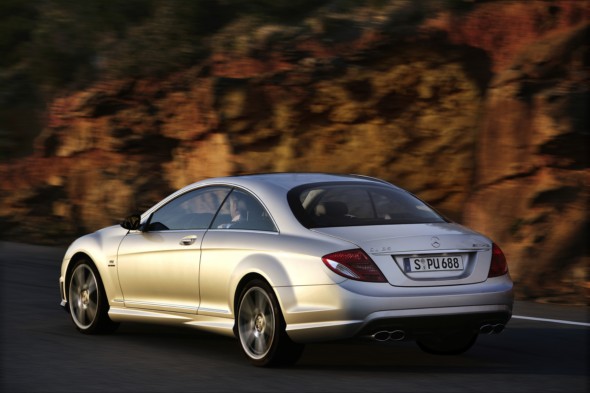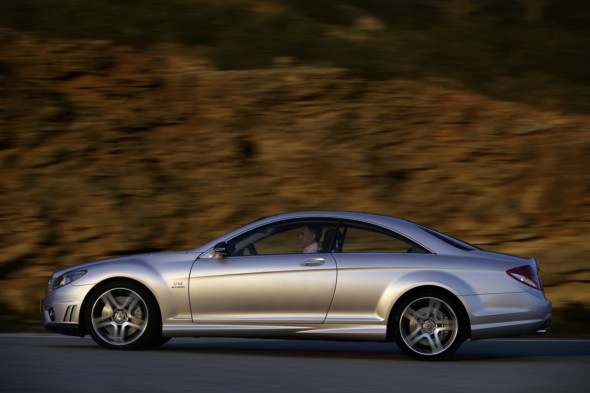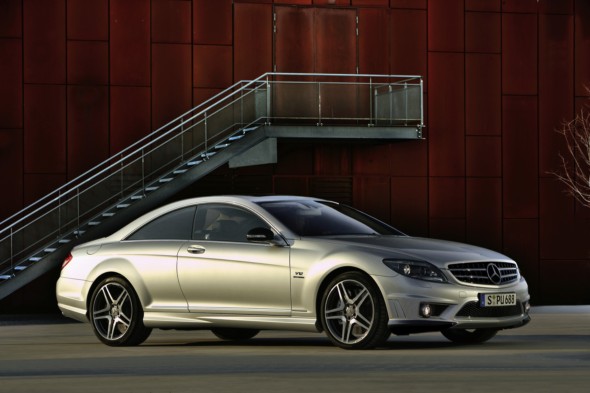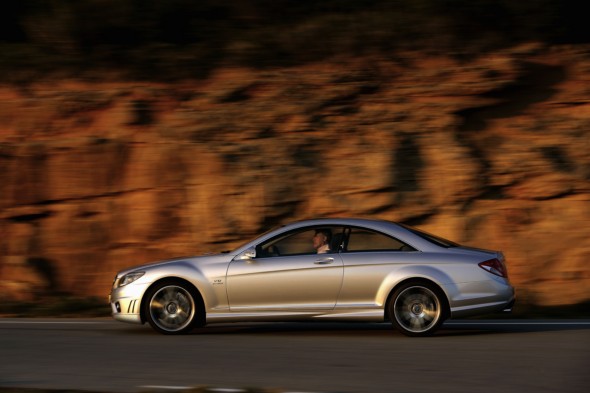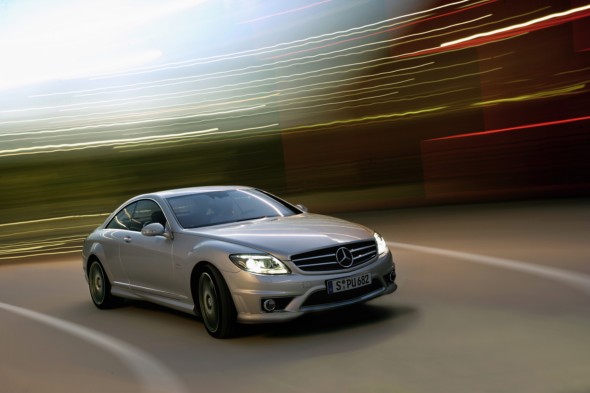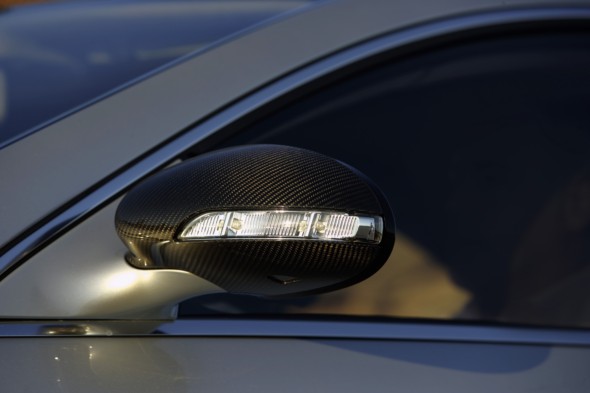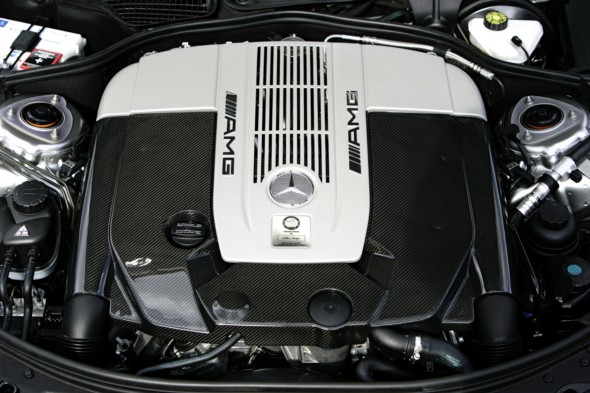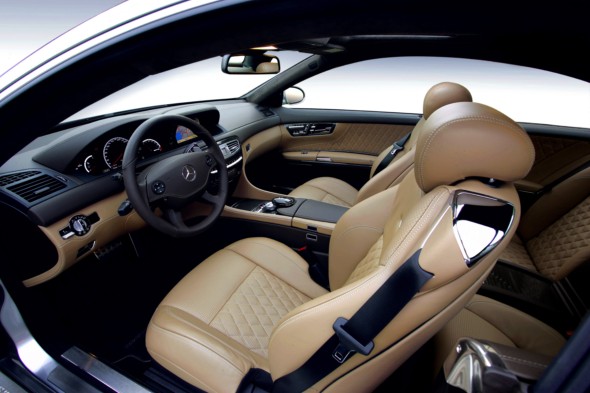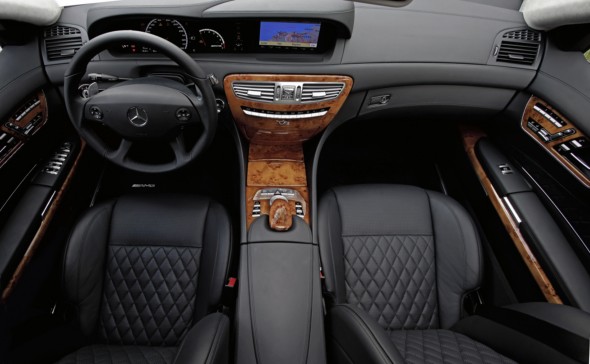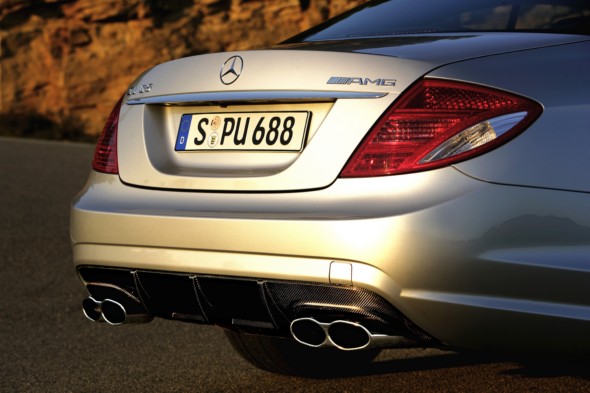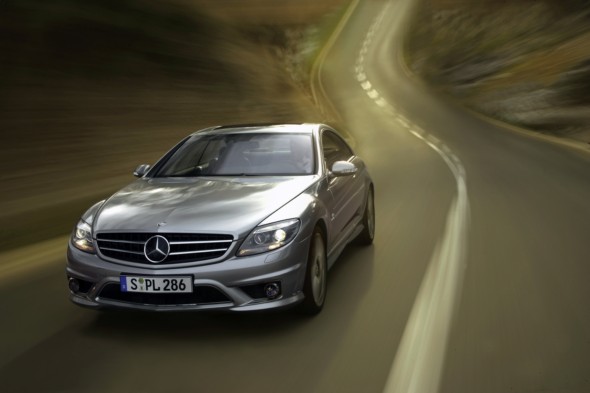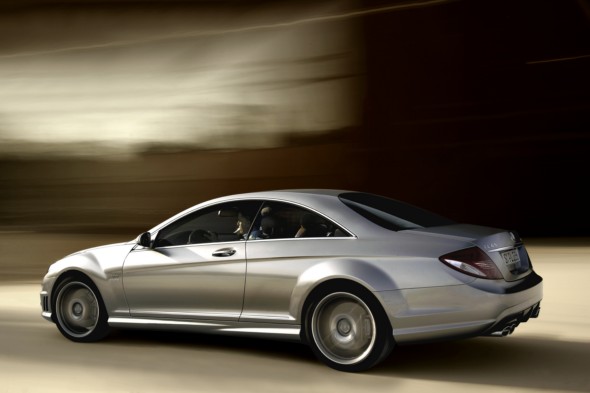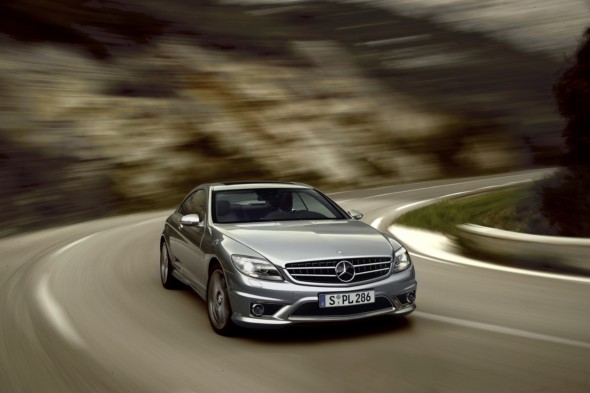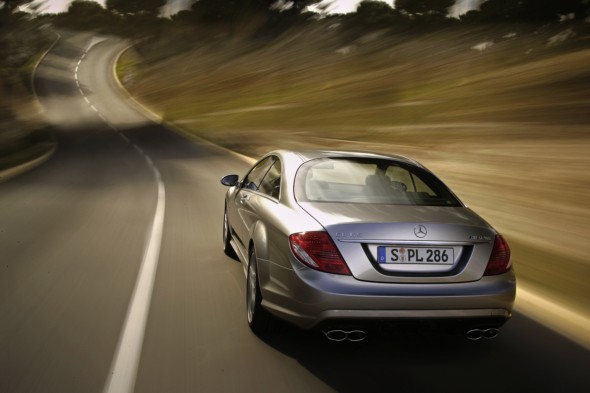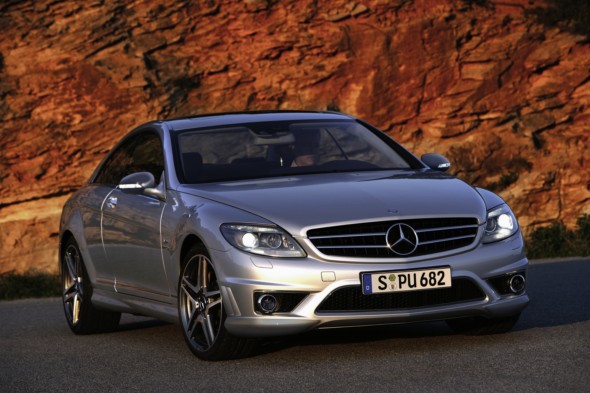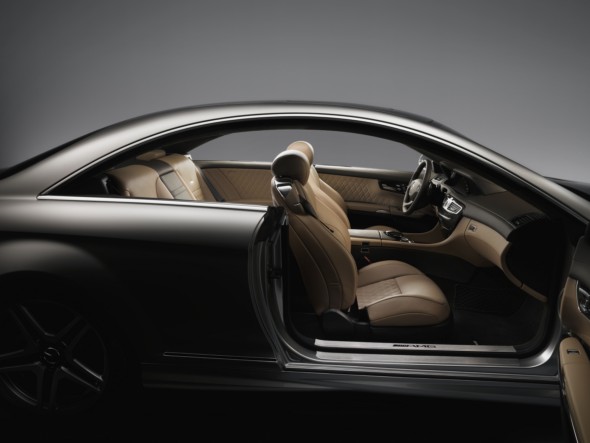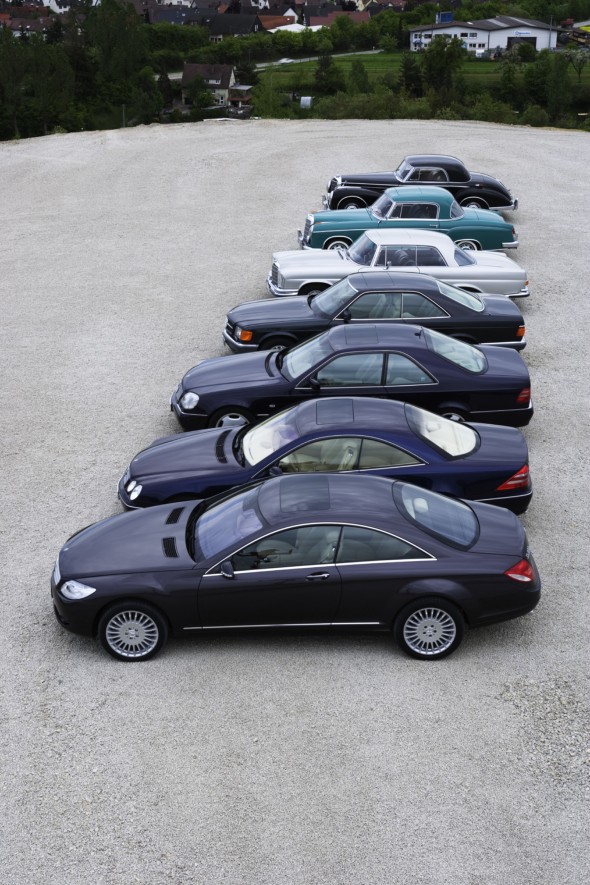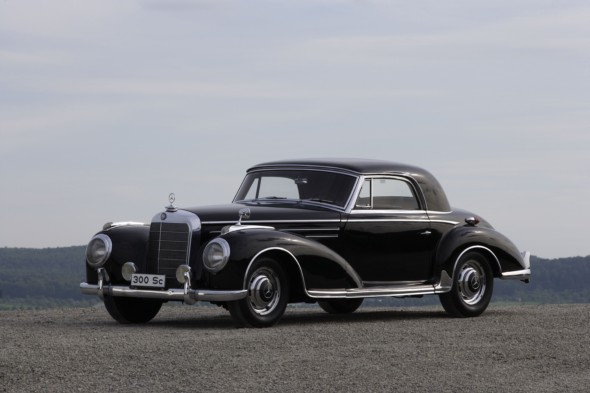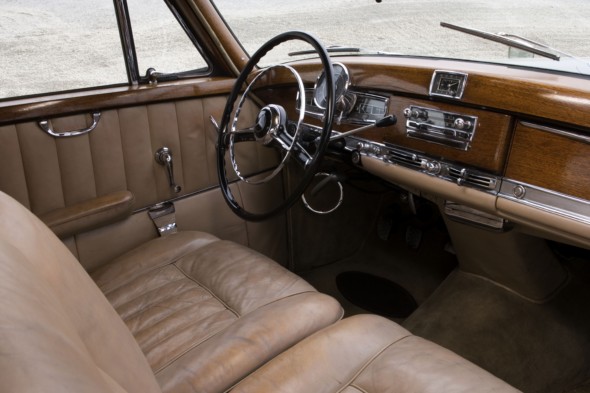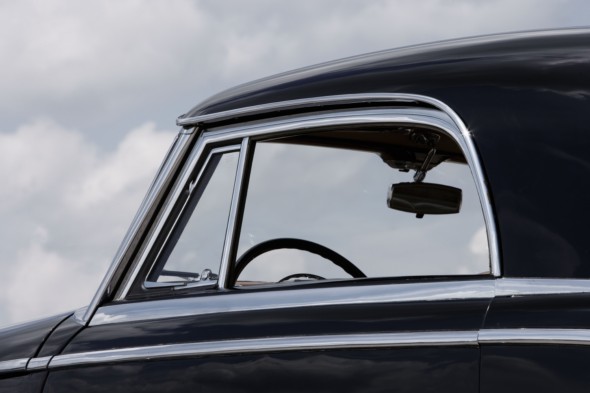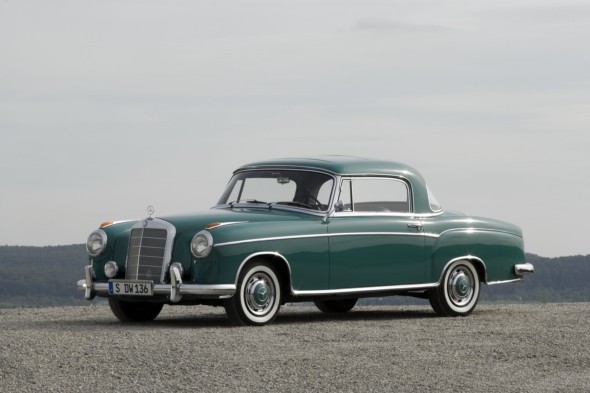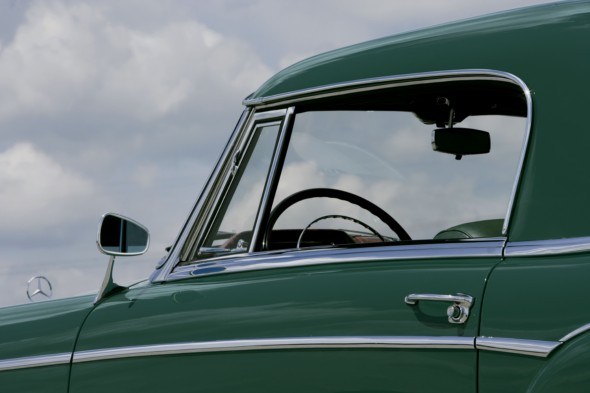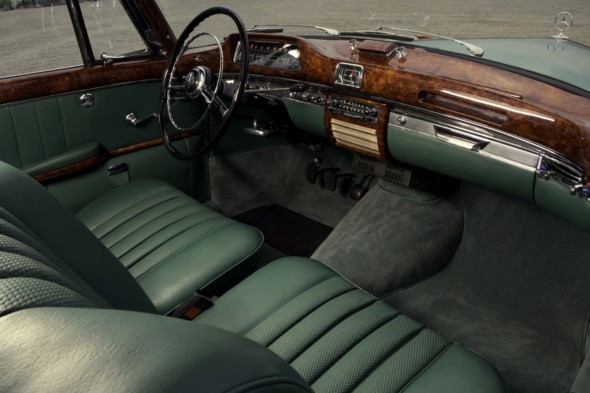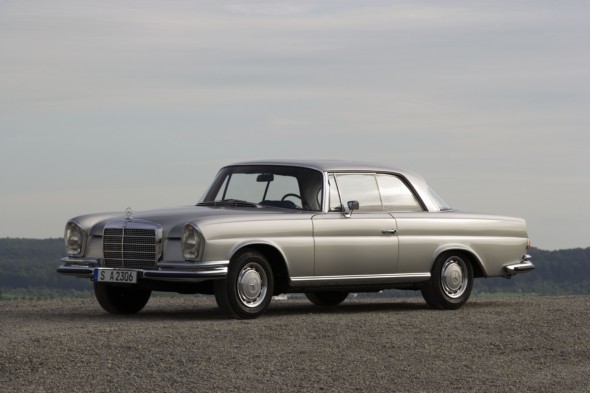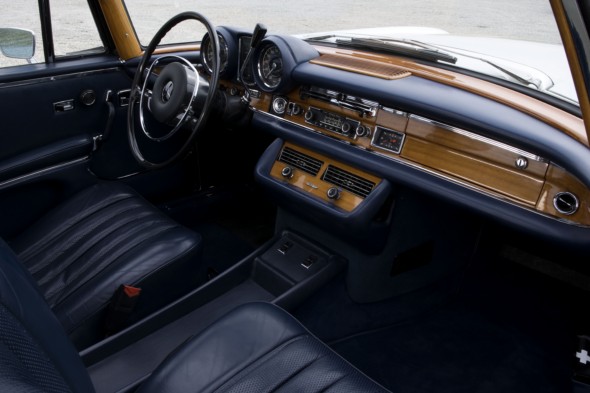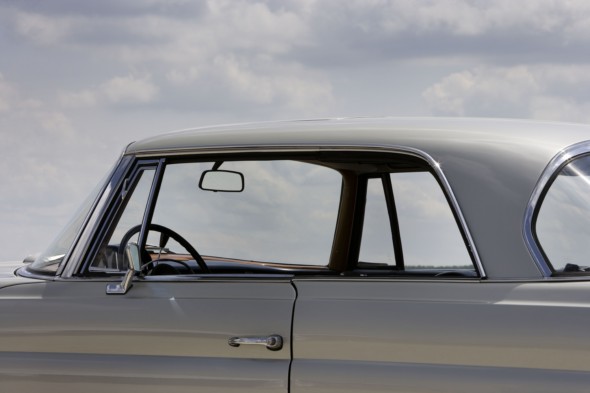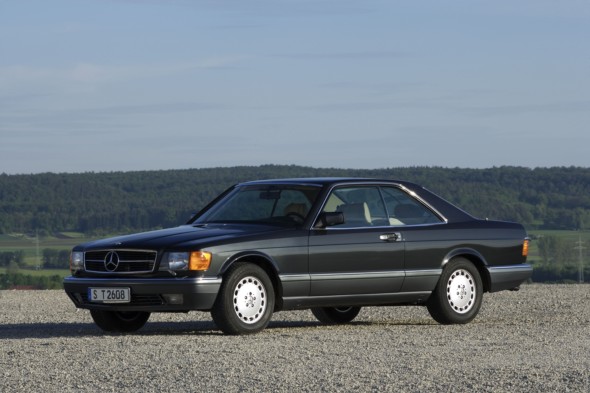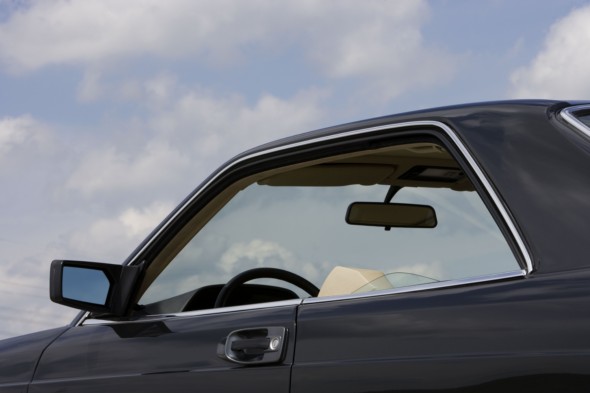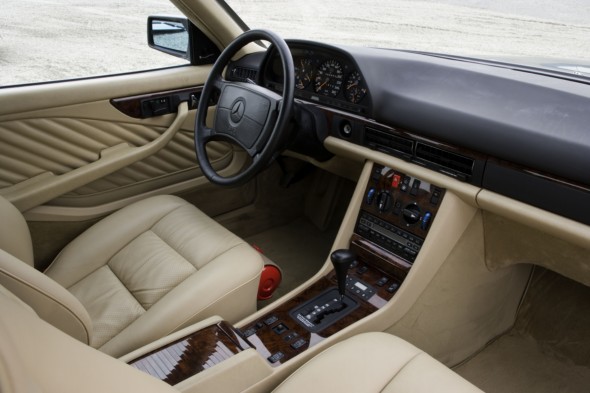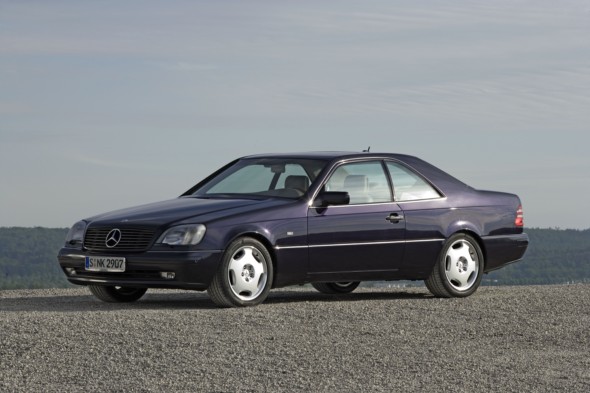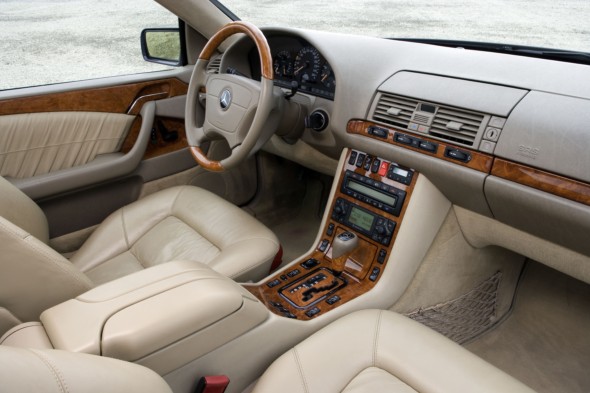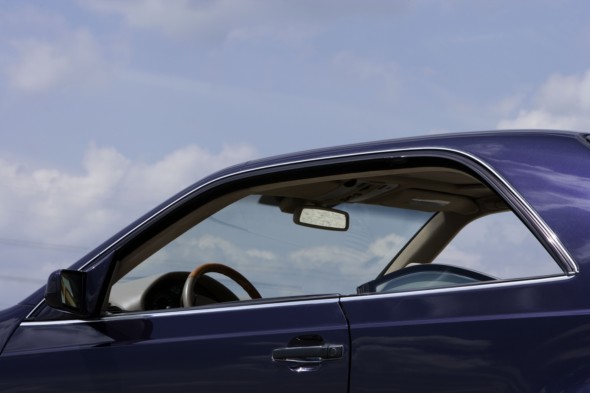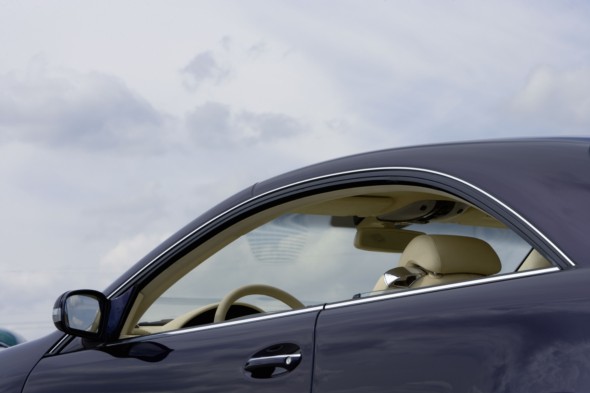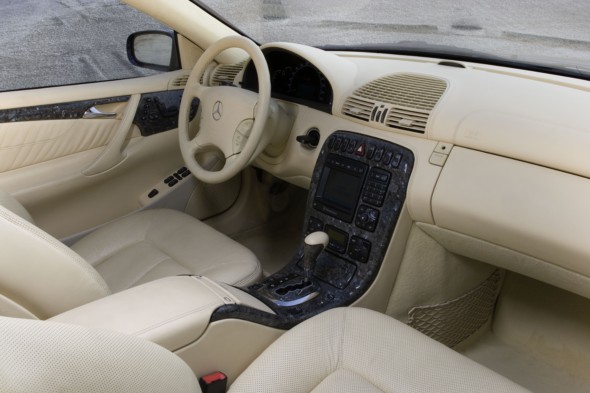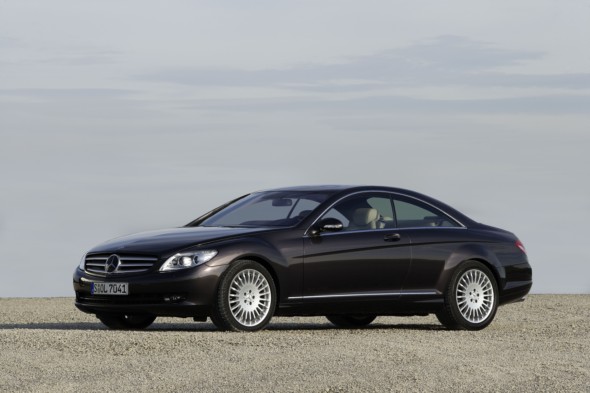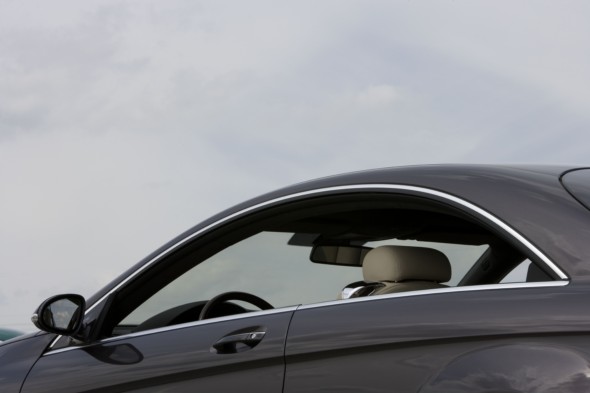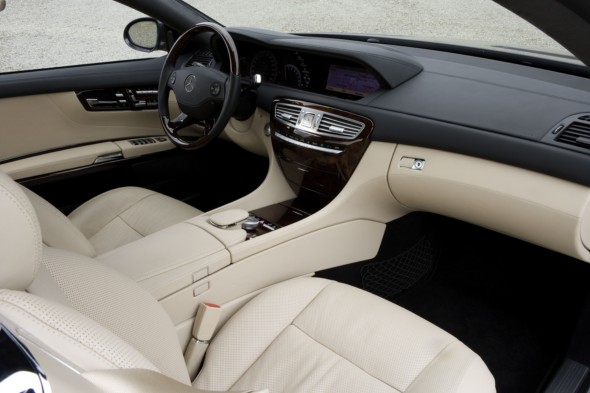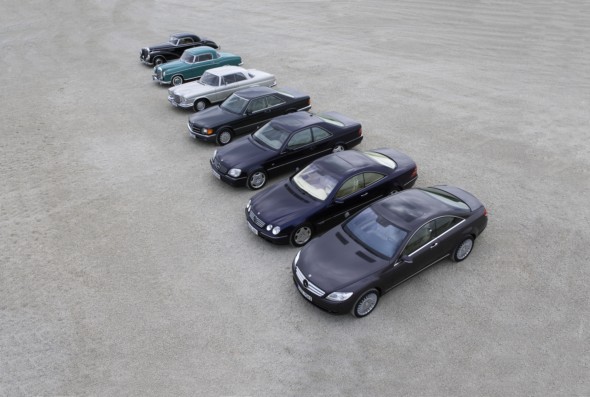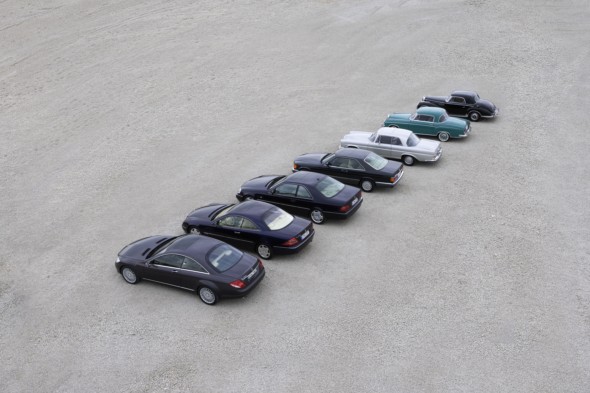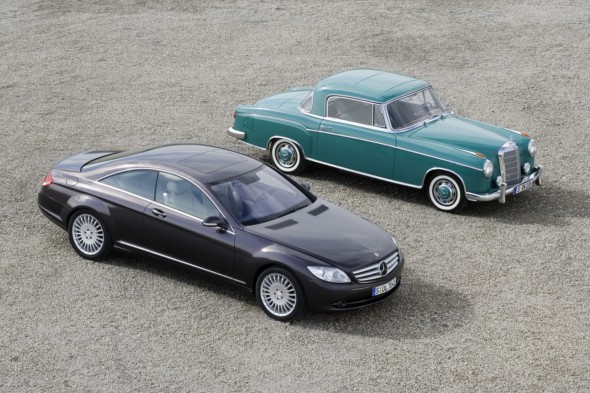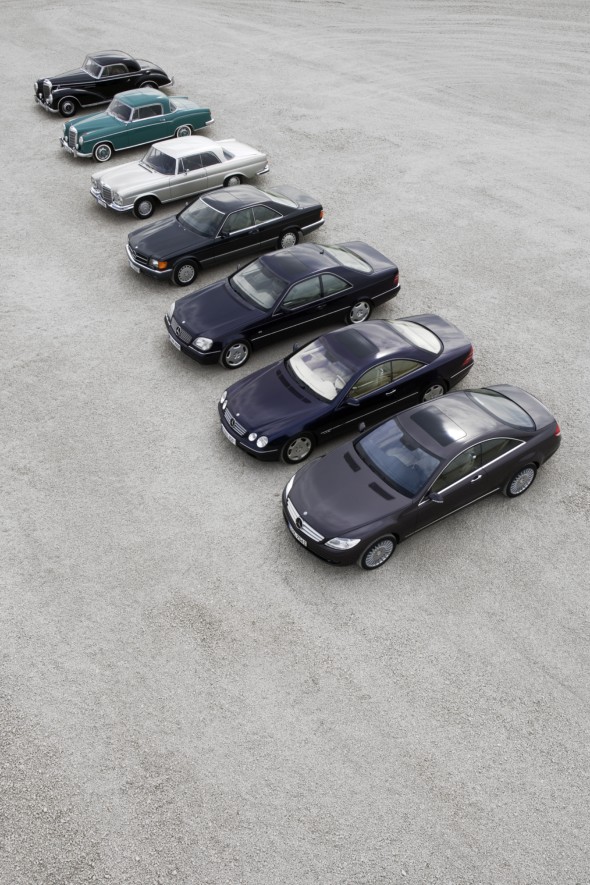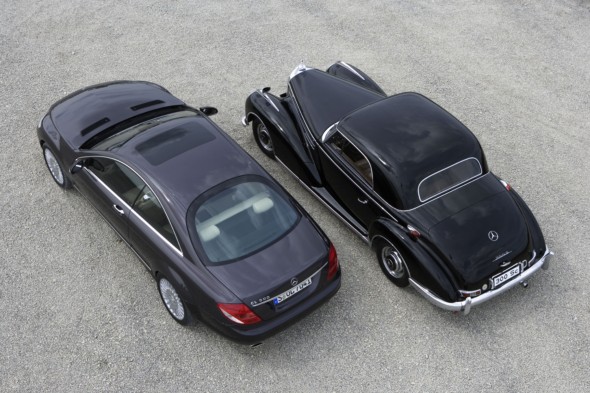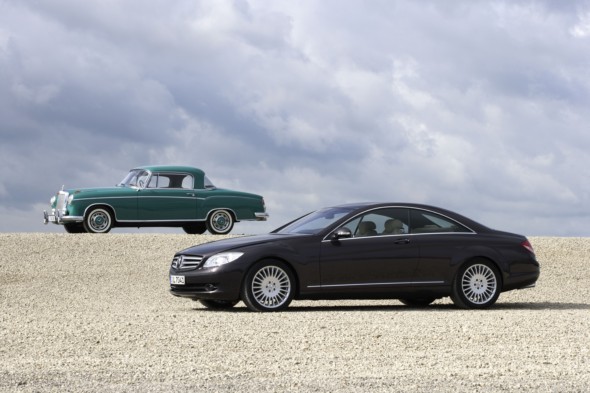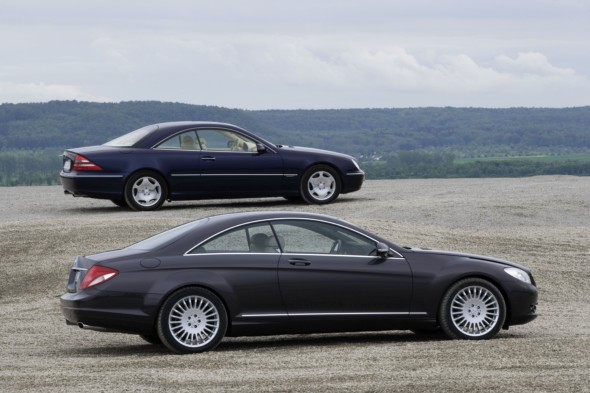CL-Class: New twelve-cylinder CL 65 AMG with 612 hp and 1000 newton metres of torque

- AMG’s most powerful engine
- Outstanding performance at super-sportscar levels
- Active Body Control specially optimised for AMG performance
- Exclusive features including 19-inch AMG wheels and fine nappa leather
Six months after celebrating the company’s 35th anniversary, Mercedes-AMG GmbH is proud to present its most powerful model to date in the shape of the CL 65 AMG. This exclusive flagship coupé is powered by a newly designed 6‑litre V12 engine whose biturbo technology gives it a level of performance previously unheard of in this engine size class: the twelve-cylinder power plant has an output of 450 kW/612 hp and develops its maximum torque of 1000 newton metres between 2000 and 4000 rpm.
Thanks to these impressive engine data, the Coupé has the performance characteristics of a thoroughbred sports car and is able to accelerate from 0 to 100 km/h in just 4.5 seconds (provisional figure) and on to an electronically limited top speed of 250 km/h. The CL 65 AMG will have its market launch in autumn 2003.
The new V12 engine embodies the expertise which Mercedes-AMG has always brought to the development of powerful twelve-cylinder cars which set the benchmark for their particular segment: in 1995, the 7.3-litre SL 73 AMG caused a sensation with its output of 386 kW/525 hp; in 1997, the street version of the CLK-GTR with its 440 kW/600 hp 6.9-litre V12 set new standards for super-sportscars; in 2001, Mercedes-AMG presented another two exclusive V12 high-end models in the form of the S 63 AMG and the CL 63 AMG (326 kW/444 hp).
For Mercedes-AMG, this impressive V12 tradition represents both an obligation and an incentive to offer the company’s customers an exceptional engine concept. The increase in the displacement from 5513 to 5980 cc is just one of many measures responsible for the enhanced performance and torque available:
- The cylinder bore in the diecast aluminium crankcase has been increased from 82.0 to 82.6 millimetres.
- The precision-balanced crankshaft is made from higher-strength material and its stroke has been extended from 87 to 93 millimetres.
- The forged pistons, which are made from a special material which is extremely resistant to temperature and pressure, have an upgraded oil-spray cooling system with a separate individual nozzle per piston. The size of the piston pins has been increased.
- The main and conrod bearings are made from higher-specification material for enhanced handling of thermal and pressure peaks.
- The combustion chambers in the cylinder heads have been optimised.
- The camshafts have increased stroke on the intake side and longer opening times.
- The modified oil pump and the larger oil cooler ensure that all lubrication points are supplied with oil — even under the most extreme conditions.
- The housings of the compressor and turbine in both turbochargers have been enlarged, as have the turbine and compressor wheels. The maximum charge pressure has been increased to 1.5 bar.
- Larger injection valve openings permit increased fuel throughput.
Larger low-temperature radiator for high power output
High power output is guaranteed under all operating conditions thanks to the new design of the intercooler which features a front-mounted low-temperature radiator that is about 70 percent larger. The system pressure of the computer-controlled fuel system has been increased to 3.8 bar in order to ensure an adequate fuel supply to the twelve cylinders in all driving situations. A completely revised electronic engine management system, which also includes new wastegate valve actuation control for both turbochargers, completes the list of major modifications to be found in the new AMG V12.
The characteristically rich sound of an AMG twelve-cylinder engine is due to the new AMG exhaust system featuring a new muffler design and two twin tailpipes. The CL 65 AMG already complies with the EU-4 exhaust emission standard which comes into force from 2005.
A special plate on the new engine cover reflects the exclusive character of the high-performance V12 biturbo power plant. The “one man, one engine” philosophy is documented by the signature of the specialist who assembled the twelve-cylinder unit by hand in the AMG engine facility. Key engine data at a glance:
CL 65 AMG
| |||
| Cylinders/valves per cylinder | V12/3 | ||
| Displacement cc | 5980 | ||
| Bore x stroke mm | 82.6 x 93.0 | ||
| Output kW/hp at rpm | 450/612 4750-5100 | ||
| Torque Nm at rpm | 1000 2000-4000 | ||
| 0 – 100 km/h s
| 4.5* | ||
Top speed km/h
| 250** |
* provisional figure; ** electronically limited
Upgraded driveline: Five-speed automatic transmission and steering-wheel gearshift controls
Power is transmitted by a five-speed automatic transmission with SPEEDSHIFT and steering-wheel-mounted gearshift controls. Various transmission components have been optimised to ensure safe and reliable handling of the high maximum torque level of 1000 newton metres, which is available across a broad engine-speed range (between 2000 and 4000 rpm). These include
- … newly developed converter discs with a high-quality metal coating;
- … the larger torque-converter lockup clutch;
- … the modified shift and torque-converter-lockup logic.
The upgraded rear differential, more rigid drive shafts and reinforced hub carriers also reflect the high level of power and torque available.
Active Body Control with AMG sports suspension and high-performance braking system
The CL 65 AMG is equipped as standard with Active Body Control (ABC) and special AMG spring struts designed for a firmer response. Dynamic handling control systems such as ABS, Brake Assist, ASR and ESP® had to be fully reworked in order to cope with the high level of power available from the biturbo engine.
When designing the AMG high-performance braking system, the engineers drew on their extensive experience acquired during more than three decades of motorsport. The front wheels are equipped with a newly developed eight-piston composite brake with a 390 x 36 mm grey cast-iron disc and aluminium brake-disc bowl.
Compared with conventional braking systems, this system offers a weight saving of about 20 percent and also has a greater thermal capability. Contact with the road is taken care of by AMG 19-inch twin-spoke wheels equipped with mixed-size tyres. The 8.5-inch-wide front wheels are fitted with 245/40 ZR 19 tyres, while the 9-inch-wide rear wheels have 275/35 ZR 19 tyres.
AMG styling and superb nappa leather appointments
The CL 65 AMG is equipped as standard with the distinctive AMG styling package; the chromed “V12 Biturbo” lettering on both front wings indicates the exceptional dynamic qualities of this top coupé.
This sporty exterior is complemented by the superb interior appointments: the “Exclusive Nappa” leather upholstery, which is available in three colours, and the extensive use of fine wood trim elements create a particularly stylish ambience. Electrically adjustable sports seats with the exclusive AMG piping layout and perforation pattern, optimised lateral support, memory function, and seat heating make every journey a delight, whether it involves twisting country roads or long-distance motorway cruising. The distinctive style of the twelve-cylinder flagship model is rounded off by the instrument cluster calibrated up to 360 km/h, the ergonomic steering wheel with gearshift buttons, and the chromed stainless-steel door sills.
In detail
The technology of the CL 65 AMG and S 65 AMG:
A new dimension of performance and dynamism
- New V12 AMG biturbo engine with a displacement of 5980 cc
- Enhanced charge-air cooling for higher power output
- AMG SPEEDSHIFT five-speed automatic transmission with steering-wheel controls
- Active Body Control specially optimised for AMG
- Upgraded AMG high-performance composite brake system
AMG – three letters which have stood for a dynamic and innovative company for over 35 years. This name is also synonymous with exceptional high-performance cars characterised by compelling power delivery, superb dynamic qualities and exclusive appointments. The Mercedes-Benz CL 65 AMG and S 65 AMG embody all these strengths to perfection and set new standards with their exceptional engine specifications and performance figures.
It is only at second glance that the casual observer picks up the visual cues which hint at the exceptionally advanced technology to be found in these high-performance cars. But with the engine running – even if it is only at idling speed – the characteristically rich AMG sound makes it clear that a very special power plant is at work under the bonnet.
Equipped with a biturbo system and air/water intercooling, the 5980 cc V12 engine has a maximum output of 450 kW/612 hp and develops 1000 newton metres of torque. Maximum power is available throughout the 4800 – 5100 rpm range while the maximum torque is on tap between 2000 and 4000 rpm. The 570 newton metres of torque which the AMG V12 biturbo engine delivers to the crankshaft at just 1000 rpm rises to 830 newton metres 500 rpm later.
Outstandingly high specific output and torque values
Not even seasoned engine specialists could fail to be impressed by the outstanding performance data of the most powerful engine ever produced by AMG. Its specific output is 75.3 kW/102.3 hp per litre of swept volume, while its specific torque is 167.2 newton metres per litre of swept volume. The maximum mean effective pressure, an absolute measure of an engine’s performance, is 21.0 bar at the maximum torque of 1000 newton metres. These figures mean that the new AMG V12 power plant outperforms every other series-production turbocharged/ supercharged petrol engine in the passenger-car sector.
A new dimension of performance
These outstanding engine data open up a new dimension of performance figures. Both the CL 65 AMG and the S 65 AMG accelerate from 0 to 100 km/h in just 4.4 seconds and reach the 200 km/h mark in 13.3 seconds while a standing-start kilometre takes 22.0 seconds. Although the maximum speed is electronically limited to 250 km/h, a look at the speedometer which is calibrated up to 360 km/h confirms the potential of the two new AMG cars.
But the AMG twelve-cylinder power plant is also ideally suited for relaxed cruising in high gear. Superbly responsive, yet smooth and refined, it guarantees the high level of touring comfort traditionally associated with Mercedes.
Key data at a glance:
CL 65 AMGS 65 AMG | ||
| Cylinders/valves per cylinder | V12/3 | |
| Displacement cc | 5980 | |
| Bore x stroke mm | 82.6 x 93.0 | |
| Output kW/hp at rpm | 450/612 4800 – 5100 | |
| Torque Nm at rpm | 1000* 2000 – 4000 | |
| 0 – 100 km/h s | 4.4 | |
| 0 – 200 km/h s | 13.3 | |
| NEDC combined fuel cons. l/100 km | 14.9 | |
| Top speed km/h | 250* |
* electronically limited
Long tradition of twelve-cylinder engines from Mercedes-AMG
The new V12 engine embodies the expertise which Mercedes-AMG has always brought to the development of powerful twelve-cylinder cars which set the benchmark for their particular segment. In 1995, the 7.3-litre SL 73 AMG caused a sensation with its output of 386 kW/525 hp; in 1997, the street version of the CLK-GTR with its 450 kW/612 hp 6.9-litre V12 set new standards for super sports cars. In 2001, Mercedes-AMG presented another two exclusive V12 high-end models in the form of the S 63 AMG and the CL 63 AMG (326 kW/444 hp).
New engine features extensive internal and external enhancements
This long tradition of building outstanding V12 power plants has created high expectations and spurred Mercedes-AMG on once again to provide its customers with a superlative engine concept. As a result, the design of the biturbo engine has been thoroughly revised. The increase in the displacement from 5513 to 5980 cc is just one of many measures responsible for the enhanced performance and torque.
The following design changes have been made:
- The cylinder bore in the diecast aluminium crankcase has been increased from 82.0 to 82.6 millimetres.
- The precision-balanced crankshaft is made from high-strength material and its stroke has been extended from 87 to 93 millimetres.
- The forged pistons, which are made from a special material which is extremely resistant to temperature and pressure, have an upgraded oil-spray cooling system with a separate individual nozzle per piston. The size of the piston pins has been increased.
- The main and conrod bearings are made from higher-specification material for enhanced handling of thermal and pressure peaks.
- The combustion chambers in the cylinder heads have been optimised.
- The camshafts have increased stroke on the intake side and longer opening times.
- The modified oil pump and the larger oil cooler ensure that all lubrication points are supplied with oil — even under the most extreme conditions.
- The housings of the compressor and turbine in both turbochargers have been enlarged, as have the turbine and compressor wheels. The maximum charge pressure has been increased to 1.5 bar.
- Larger injection valve openings permit more effective fuel throughput.
- Larger low-temperature radiator guarantees high power output
Another redesigned feature is the intercooler which is equipped with a front-mounted low-temperature radiator that is about 70 percent larger than before. The system uses the particularly efficient air/water heat-exchanger principle to cool the intake air (which has been compressed by the turbochargers) before it enters the combustion chambers. The larger area of the low-temperature radiator results in a 25 percent reduction in the intake-air temperature at full load. This system guarantees high power and torque levels whatever the outside temperature or operating conditions.
The electronically controlled fuel supply system which incorporates newly developed components works with a system pressure of 3.8 bar in order to ensure an adequate fuel supply to the twelve cylinders in all driving situations. A completely revised electronic engine management system, which also includes new wastegate valve actuation control for the two exhaust-gas turbochargers, completes the list of substantial modifications to be found in the new AMG V12.
The characteristically rich AMG twelve-cylinder engine note comes courtesy of
the new AMG sports exhaust system featuring a new muffler design and two twin chromed tailpipes. Thanks to the use of three valves per cylinder, dual ignition and efficient catalytic-converter technology, the CL 65 AMG and the S 65 AMG already comply with the EU-4 exhaust emission standard which comes into force from 2005.
“One man, one engine” in the AMG engine facility
The unique character of the high-performance AMB biturbo power plant becomes obvious as soon as the bonnet is opened. The redesigned engine cover, which is made from deep-drawn aluminium and carbon-fibre reinforced plastic (CFRP) is impressive to look at and weighs just 1500 grams.
The twelve-cylinder engine is assembled by hand on the topmost floor of the AMG engine facility – right next to the line where the supercharged AMG V8 for the new Mercedes-Benz SLR McLaren is produced. The “one man, one engine” philosophy is reflected by the characteristic signature plate on the AMG V12 which bears the name of the specialist who assembled the engine and guarantees the highest standards of quality and workmanship.
Upgraded driveline: Five-speed automatic transmission and steering-wheel gearshift controls
Power is transmitted by the AMG SPEEDSHIFT five-speed automatic transmission with steering-wheel-mounted gearshift controls. Various transmission components have been optimised to ensure safe and reliable handling of the high maximum torque level of 1000 newton metres, which is available between 2000 and 4000 rpm. These include:
- … newly developed clutch pack discs with a high-quality metal coating,
- … optimised shift and torque-converter-lockup logic.
Redesigned drive shafts and upgraded hub carriers also reflect the high levels of power and torque available.
Innovative Active Body Control with AMG sports suspension
Launched in 1999, the Mercedes-Benz CL-Class was the very first series-production car to feature active-suspension technology. Today, the Mercedes-Benz CL-Class, S-Class and SL-Class model series are the only vehicles in the world to offer this innovative system which reconciles the conflicting goals of safety, dynamic handling and ride comfort. Active Body Control (ABC) uses high-pressure hydraulics, sophisticated sensors and powerful microprocessors to adjust the suspension response to the current driving situation with split-second accuracy. The active suspension system eliminates almost all body movement when moving off, cornering and braking. It also reduces body roll very effectively when negotiating a curve or when avoiding an obstacle.
The CL 65 AMG and S 65 AMG are equipped as standard with Active Body Control and special AMG spring struts with a firmer damping response for highly dynamic handling. The driver can also select an even sportier mode at the touch of a button. Furthermore, the latest ABC suspension system features a special function which takes account of the current vehicle load when calculating the active suspension settings. If the vehicle is heavily laden with passengers and/or luggage, for example, the ABC computer calls on corresponding control algorithms and reduces the roll angle of the body – with the result that the dynamic handling values are identical to those of an unladen vehicle.
The dynamic handling control systems such as ABS, Brake Assist, ASR and ESP® (Electronic Stability Program) have had to be fully reworked in order to cope with the high level of power available from the biturbo engine.
Upgraded AMG high-performance braking system for front wheels
When designing the AMG high-performance braking system, the engineers drew on their extensive experience acquired during more than three decades of motorsport. The front wheels are equipped with a newly developed brake system featuring eight-piston fixed callipers with 390 x 36 mm internally ventilated and perforated composite discs. Compared with conventional brake systems, this composite technology, which makes allowance for axial and radial expansion of the discs, offers a weight saving of some 20 percent and also has a greater thermal capability – an attribute which has significant benefits with regard to durability. The rear wheels are equipped with four-piston brake callipers with 348 x 26 mm internally ventilated and perforated discs. The combination of these two systems gives the
CL 65 AMG and S 65 AMG the stopping power to match their performance.
Contact with the road is taken care of by multi-piece 19-inch AMG twin-spoke wheels with mixed tyres. The 8.5-inch-wide front wheels are fitted with 245/40 ZR 19 tyres, while the 9.5-inch-wide rear wheels have 275/35 ZR 19 tyres.
Mercedes-Benz CL 65 AMG and S 65 AMG:
450 kW/612 hp and 1000 Nm of torque make them the most powerful models ever produced by AMG
- Powerful twelve-cylinder AMG biturbo engine
- A new dimension of performance
- Active Body Control specially optimised for AMG performance
- Exclusive features including 19-inch AMG wheels and fine nappa leather
The new CL 65 AMG and S 65 AMG from Mercedes-AMG GmbH are the most powerful models the brand has produced since it was established 37 years ago. The exclusive Gran Turismo and the dynamic luxury saloon are powered by a newly designed 6‑litre V12 engine whose biturbo technology gives it a level of performance previously unheard of in this engine size class: the twelve-cylinder AMG powerplant has an output of 450 kW/612 hp and develops its maximum torque of 1000 Nm between 2000 and 4000 rpm. These impressive figures are responsible for a new dimension of performance: both vehicles can accelerate from 0 to 100 km/h in 4.4 seconds and on to an electronically limited top speed of 250 km/h.
Much of the credit for this impressive performance is shared by the all-new design of the biturbo system, which features larger turbochargers and a new, more powerful charge-air cooling system, and the increase in the engine displacement (to 5980 cc) as well as many other engine design measures.
AMG SPEEDSHIFT five-speed automatic transmission with steering-wheel controls
Power is transmitted by the AMG SPEEDSHIFT five-speed automatic transmission with steering-wheel gearshift controls. The engine’s high maximum torque level of 1200 Nm has been limited electronically to 1000 Nm and a number of measures – including the adoption of newly developed clutch pack discs with a high-quality metal coating as well as modified shift and torque-converter-lockup logic – have been taken to optimise key transmission components. The modified drive shafts and upgraded hub carriers also reflect the high levels of power and torque available.
Active Body Control with sports suspension, eight-piston composite brake system
The CL 65 AMG and S 65 AMG are equipped as standard with Active Body Control (ABC) and special AMG spring struts with firmer damping. Fully reworked dynamic handling control systems such as ABS, BAS, ASR and ESP®(Electronic Stability Program) complement the enhanced chassis set-up. In order to cope with the high power output of the AMG biturbo engine, the front wheels of both the AMG V12 flagship models are equipped with a newly developed, high-performance eight-piston composite brake system with 390 x 36 mm grey cast-iron discs and aluminium brake-disc bowls. Contact with the road is taken care of by AMG 19-inch twin-spoke wheels fitted with 245/40 ZR 19 tyres at the front and 275/35 ZR 19 tyres at the rear.
AMG bodystyling and exclusive nappa leather appointments as standard
The CL 65 AMG and the S 65 AMG feature the distinctive, powerful looks of AMG bodystyling, which is standard on both vehicles. The front and rear aprons as well as the side skirts blend harmoniously with the timelessly elegant design of the Mercedes models. The chromed “V12 Biturbo” lettering on the front wings indicates the exceptional dynamic qualities of these vehicles, while the two oval-shaped, chrome-finished twin tailpipes of the AMG sports exhaust system add a sporty touch at the rear.
Inside, a particularly stylish ambience is created by the extensive use of fine wood trim elements and the “Exclusive nappa” leather upholstery, which is available in three colours. Electrically adjustable AMG sports seats with the exclusive AMG upholstery piping layout and perforation pattern, optimised lateral support, multicontour and memory functions as well as seat heating make every journey in the CL 65 AMG a delight, whether it involves twisting country roads or long-distance motorway cruising. The S 65 AMG has dynamic multicontour front seats which are electrically adjustable and feature a memory function and seat heating as well as the characteristic AMG upholstery piping and perforation pattern. The distinctive style of the twelve-cylinder flagship models is rounded off by the AMG instrument cluster calibrated up to 360 km/h, the AMG ergonomic steering wheel with gearshift buttons, and the chromed stainless-steel door sills featuring the AMG logo.
The standard equipment of the S 65 AMG also includes the PRE-SAFE anticipatory occupant protection system which can recognise a potential accident situation early enough to take appropriate measures to prepare the occupants and the vehicle.
CL 65 AMG and S 65 AMG – design and appointments: An impressive combination of AMG styling, exclusive standard equipment and optimum occupant safety
- Harmoniously integrated AMG styling emphasises sporty character
- Highlights include 19-inch AMG twin-spoke wheels
- Fine nappa leather appointments available in three colours
- Sports seats and dynamic multicontour seats as standard
- AMG instrument cluster calibrated to 360 km/h
- Pioneering PRE-SAFE occupant protection system in S 65 AMG
The CL and S-Class have picked up several major awards in recent years for their fine styling. Sporty elegance meets the long-term quality which is characteristic of Mercedes. The task facing the designers of the CL 65 AMG and the S 65 AMG was to make subtle dynamic enhancements to the bodies of both V12 flagship models whilst remaining true to the fundamental design philosophy.
Both V12 flagship models feature the characteristic AMG styling as standard. The AMG front apron with the large cooling-air intakes and, on the CL 65 AMG, the integral clear-lens fog lamps give the vehicles a distinctive “face”. The dynamic quality of the side view is emphasised by the side skirts, which pick up the line
of the front apron, and by the chromed “V12 Biturbo” lettering on the front wings. Apart from being eye-catching highlights in their own right, the attractive, multi-piece 19-inch AMG light-alloy wheels with their twin-spoke design complement the overall picture. The rear is rounded off by two chromed twin tailpipes and the powerful lines of the rear apron – the latter featuring an exclusive and sporty diffusor look in the case of the CL 65 AMG.
This dynamic exterior is complemented by the exquisite interior appointments: a particularly stylish ambience is created by the extensive use of fine wood trim elements and the “Exclusive nappa” leather upholstery, which covers not only the seats, but also the door panels, the entire dashboard, the side sections of the centre console and the rear shelf; the roof lining is finished in fine Alcantara. Three colours of leather are available for the interior appointments of the two models: anthracite, java and alpaca grey.
Sports seats in the CL 65 AMG, dynamic multicontour seats in the S 65 AMG
In the CL 65 AMG, electrically adjustable AMG sports seats – featuring the exclusive AMG design and perforation pattern, AMG badges, optimised lateral support, multicontour functionality, memory and seat heating – make every journey a delight, whether it involves twisting country roads or long-distance motorway cruising. The S 65 AMG has dynamic multicontour front seats which are electrically adjustable and feature a memory function and seat heating as well as the characteristic AMG upholstery piping and perforation pattern. The special multicontour function, which automatically adjusts the degree of lateral support provided by the seat, is particularly beneficial during fast cornering. Air chambers in the front of the cushion, the lumbar area and the side bolsters of the backrest are inflated or deflated by an electropneumatic system controlled by a microcomputer which processes data about the steering angle, lateral acceleration and vehicle speed in fractions of a second.
The distinctive style of the new twelve-cylinder flagship models is rounded off by the AMG instrument cluster calibrated up to 360 km/h, the AMG ergonomic steering wheel with gearshift buttons, the leather/wood selector lever and the chromed stainless-steel door sills with the AMG logo.
The comprehensive range of standard equipment in the CL 65 AMG and the S 65 AMG also includes:
(Selection)
- Car phone
- Bi-xenon headlamps
- COMAND system with powerful DVD navigation unit, 16:9 display, CD/radio and cassette player
- Rear bench seat with electrically adjustable outer seats (S 65 AMG)
- Speed-sensitive power steering
- Parktronic
- Electrically operated blind for rear window
- BOSE Sound System
The following optional extras allow customers to individualise their vehicles:
(Selection)
- Distronic proximity control
- Single-colour and two-tone designo leather upholstery, designo fine wood trim elements, designo stone trim elements (CL 65 AMG) and 13 designo metallic paint finishes
- Keyless-Go
- Rear air-conditioning system (S 65 AMG)
- Luxury seats front/rear, with ventilation and heating functions
- Multifunction system with fax, copier, printer, scanner and modem,
integrated in rear arm rest (S 65 AMG) - LINGUATRONIC voice-operated control system
- TV tuner
- TV screen in rear (S 65 AMG)
S 65 AMG features the outstanding PRE-SAFE occupant protection system
The standard equipment in the S 65 AMG includes the PRE-SAFE anticipatory occupant protection system, which is able to recognise a potential accident situation early enough to take appropriate measures to prepare the occupants and the vehicle. The anticipatory occupant protection measures include the almost instantaneous tensioning of the seat belts so that the driver and front passenger are in the optimum position to benefit from the airbags if an impact should occur. At the same time, PRE-SAFE also ensures that the front passenger seat and individual rear seats automatically assume the most favourable position for the expected impact. In the event of skidding, the system also closes the sunroof automatically.
A number of major international awards reflect the pioneering character of the innovative, high-tech PRE-SAFE system from Mercedes-Benz which has ushered
in a new era in automotive safety.
CL 65 AMG with enhanced airbag sensors
The CL 65 AMG is also equipped with highly effective occupant protection systems: newly developed up-front sensors in the front section of the body detect the severity of the impact with even greater precision and ensure that the airbags and belt tensioners are activated to the appropriate degree.
The windowbags in both models are equipped with new sensors which allow them to be deployed within 25 milliseconds if there is a risk of a rollover. Thanks to a special weight-sensing membrane in the front passenger seat, the corresponding airbag can be deployed to the appropriate extent.
The system assigns the passenger to one of four weight categories and uses this information – in combination with data about the severity of the impact – to determine whether one or both stages of the airbag gas generator should be activated. The new weight-sensing membrane represents a further development of the seat occupancy sensor system which was developed by Mercedes-Benz some years ago. This ensures that the airbag, belt tensioner and sidebag on the front passenger side are automatically deactivated if the front passenger seat is unoccupied and thereby helps to reduce the cost of accident repairs.
Testing times: The development of the high-performance V12 Mercedes-Benz CL 65 AMG and S 65 AMG
- Pre-production testing at the DaimlerChrysler Papenburg proving ground
- Twelve hand-built prototypes underwent 13 months of road testing
- From the icy cold of Sweden to the desert heat of Arizona
- 30,000 km endurance test, 5000 km at the Nürburgring
- AMG V12 engine subjected to over 2500 hours of extreme testing
It is 6.30 a.m. at the high-speed circuit of the DaimlerChrysler Papenburg proving ground. Everything is quiet with not a car to be seen anywhere as the morning mist clears. The slightly hazy outline of a large Mercedes Coupé appears on the horizon.
As the dark-blue metallic test vehicle draws ever closer, the silence of the five-lane asphalt track soon gives way to the sound of a powerful engine combined with tyre and wind noise. Then, as quickly as it arrived, the CL 65 AMG disappears from view again. “High-speed Testing” is the official – and eminently appropriate – name of this phase of the development programme at the proving ground in Germany’s Emsland region.
Equipped with electronic measuring systems, a roll-over bar, a bucket seat and a four-point racing harness, the AMG test car is being driven by Klaus Ludwig, three-time winner of Le Mans and three-time DTM champion, who has been working as a consultant to DaimlerChrysler’s development engineers since retiring from racing. After a 34-year career in international motorsport, it is hardly surprising that he remains imperturbable as the speedometer needle of the CL 65 AMG nears the 300 km/h mark. The 53 year-old former Mercedes-Benz works driver completes his final high-speed laps of the oval circuit before returning to the workshop where the engineers and specialists from Mercedes-AMG are already waiting.
“Everything’s fine; all the temperature and pressure readings are in the green zone”, announces Klaus Ludwig. “It’s very impressive: even at 260 km/h, the car still responds smoothly and effortlessly when you accelerate. You really feel you can make the most of its power out there on the high-speed circuit because all the safety-related components have been optimised to cope with it.”
Tobias Moers, who has overall responsibility for the development of the vehicle, and his colleagues Oliver Wiech (Team Leader – Cooling System/Fuel Tank), Michael Hanker (Control Systems Testing) are clearly pleased at this reassuring verdict. “We’ve been able to build up a wealth of data during the 15-month test programme”, says Tobias Moers.
“The extended trials we’ve conducted have allowed us to finalise the specification of the different components and software levels. Our work here in Papenburg focuses on optimising and approving the cooling, fuel and dynamic handling control systems so that series production of the CL 65 AMG and S 65 AMG can start on schedule.”
The 12.2 km oval circuit: one of several test facilities at the DaimlerChrysler proving ground in Papenburg
This type of pre-production approval process is one of the principal activities at the DaimlerChrysler proving ground. In addition to the 12.2 km oval circuit, on which speeds in excess of 300 km/h can be attained safely, the AMG team can make use of the wet handling course and the dry handling course, the latter being a replica of the short track at Hockenheim.
The following components and systems are the main subjects of the week-long tests which the AMG development engineers are conducting in order to confirm their ability to cope with highly dynamic driving situations:
- The newly developed charge-air cooling system with an air/water heat exchanger as well as the upgraded engine-oil cooling system of the AMG V12 biturbo engine.
- The electronically controlled fuel supply system with newly developed components.
- The completely reworked dynamic handling control systems such as ABS, Brake-Assist, ESP® (Electronic Stability Program) and ASR; the new AMG high-performance braking system with composite discs on the front wheels involved additional development work.
Achieving the impressive engine performance figures represented a particularly interesting challenge, even for seasoned members of the AMG development team. One of the central development targets in the specification book was to deliver 450 kW/612 hp and 1000 newton metres of torque in a series production vehicle without compromising the high level of touring comfort traditionally associated with Mercedes.
Tobias Moers comments: “As well as benefiting from our extensive experience in designing and developing high-performance cars, we found that AMG’s long tradition in the field of motorsport was a major advantage. Our overall aim is to offer CL 65 AMG and S 65 AMG customers the highest possible degrees of performance and safety, whatever the operating conditions.”
Dynamic handling tests on replica of the short track at Hockenheim
Once all the test results have been reviewed and the engine oil, tyres and brakes subjected to a routine check, Klaus Ludwig sets off in the silver CL 65 AMG for an hour-long test drive on the Papenburg handling course. The 2.6 km circuit is an exact replica of the short track at the Hockenheimring which developers have long regarded as the touchstone for judging a vehicle’s handling, over/understeer characteristics and traction.
He may not be battling it out with any other cars, but it is clear that Klaus Ludwig is enjoying taking the Coupé (which is packed with highly sensitive electronic measuring equipment) to the limit as he alternates between full-on acceleration and hard braking on every lap.
The tight Sachs curve, practically a 180 degree hairpin, is a punishing test for the tyres, transmission, chassis and ESP®. Thanks to the ABC chassis which has been optimised for AMG, body movement is kept to a minimum and there is no appreciable sensation of rolling in spite of the very high speed with which the car takes the corner.
Klaus Ludwig’s verdict after 50 laps: “You might think that a big Gran Turismo would be completely out of place here, but thanks to the new AMG set-up of the chassis, as well as the ABS, ASR and ESP® systems, the CL 65 AMG is able to take the short Hockenheim track in its stride. I ought to mention the new, more powerful brake system as well. That’s one of the things that makes this car such
a good drive – it’s a lot of fun, too!”
The driving style of the former DTM champion is reflected in the figures on the display of the laptop computer installed to the right of the centre console. Test engineer Michael Hanker assesses the readings it has picked up from the eight sensors built into the car. “The figures for lateral acceleration, yaw rate, steering angle and brake pressure as well as the four wheel-speed readings go straight to
the ESP® control unit. We analyse some 400 parameters by comparing them with the standard values. If there are any deviations, or if we’re not satisfied with the way the vehicle is handling, we modify the software and off we go on the next test drive “, explains the AMG development engineer responsible for the dynamic handling systems.
The wet handling course: the moment of truth for ASR and ESP®
The V12 flagship model also passes the next test with flying colours. Klaus Ludwig wastes no time in taking the CL 65 AMG to the limit on the wet handling course where the sprinklers have been turned on. The ESP® system remains activated – after all, the objective is to establish if the new control algorithms and brake application patterns will still work as intended if the vehicle’s road adhesion is suddenly compromised.
The powerful V12 biturbo engine does not have the slightest difficulty in briefly overcoming the adhesion of the 275/35 R 19 rear tyres. But the ASR acceleration skid control system intervenes smoothly and effectively to keep the vehicle right on course. The warning light in the cockpit flickers into life momentarily before the full power of the engine is once again available. As he drives, Klaus Ludwig keeps glancing at the screen of the laptop fixed next to the centre console in order to check the various displays which indicate the status of the test sequence – all the readings are just fine.
Acceleration and braking tests put the heat on the cooling system
While the former racing champion is discussing the results with head development engineer Tobias Moers in the workshop, Oliver Wiech sets out on another high-speed test run in the blue CL 65 AMG. After a number of laps at full throttle, the development engineer responsible for the cooling and fuel systems switches to a different test cycle: an alternating sequence of precisely defined acceleration and braking tests.
This is particularly tough on the water cooling, charge-air cooling and engine-oil cooling systems, as no sooner has the CL 65 AMG negotiated the banked curve of the Papenburg oval circuit at 300 km/h than it is made to stand in the full heat of the midday sun with the engine running. “I keep the twelve-cylinder power plant idling to see the effect it has on the temperature of the engine coolant, the engine oil and the coolant circuit of the air/water charge-air cooling system”, says Oliver Wiech.
The AMG engineer can check no less than 228 different parameters with the on-board laptop. The most important ones are shown clearly on the display during the actual test and are also linked to a convenient “traffic light” indicator: “If a given limit is exceeded, the colour changes from green to amber, or even red in an extreme situation. This gives me the opportunity to interrupt the test immediately to look for the cause of the problem”, explains Wiech.
The first day of testing is over and everyone is happy with the way things have gone. There have been no unexpected problems requiring design changes or a major software update. But if the AMG Team are able to relax a little now, it is only because of all the design work, bench testing and road testing they have
undertaken over the last two years.
Development timeline:
- Engine design work begins in mid-2001
- First run of engine on a steady-state test rig in winter 2001/2002; basic mechanical analysis; study of oil circuit; power optimisation with various exhaust-turbocharger and camshaft variants; definition of exhaust-emission levels; injection quantity; charge-air ducting and regulation of boost pressure
- First in-vehicle endurance tests of engine in mid-2002
- First test-rig endurance tests of engine in autumn 2002
The 42 test engines ran for a total of 5500 hours on the test rig and also had to run for over 450 hours in the course of five in-car endurance tests which were conducted in order to verify the results.
The results were drawn on continuously as the various engine components – which initially existed only in the form of hand-made prototypes – were refined and enhanced. Once the components were ready for series production, they were subjected to further endurance testing to ensure their quality.
The same procedure was used for all the other components, such as the exhaust system, brake system, chassis, transmission and powertrain. The software which controls the engine, transmission and dynamic handling control systems was also optimised in successive releases.
Overview of the principal phases of the standardised Mercedes-AMG test programme for the new CL 65 AMG and S 65 AMG:
Development of engine, transmission and powertrain
- Altitude testing in Denver, Colorado (USA), Lesotho (South Africa) and Granada (Spain)
- High-temperature testing in Death Valley, California (USA), Upington (South Africa), at the Idiada test facility (Spain) and Phoenix, Arizona (USA)
- Test drives in Los Angeles, California (USA)
- Low-temperature testing in Arctic Falls (Sweden)
Development of cooling and fuel systems
- Various test drives on the high-speed circuits in Nardo (Italy) and Papenburg
- Testing in Upington (South Africa) and Death Valley, California (USA)
- Testing in the DaimlerChrysler wind tunnel
Development of brakes and control systems
- Testing of dynamic handling control systems at the Idiada test facility (Spain), in Arjeplog (Sweden) and at the Boxberg proving ground
- Testing of the DISTRONIC proximity control in Papenburg
- Testing of the brake system on the high-speed circuit in Nardo (Italy) and on the Grossglockner Pass (Austria)
It was also necessary to conduct endurance testing in order to compress an entire (and particularly punishing) vehicle lifetime into a short period:
- North Loop of the Nürburgring: The world’s most demanding race circuit was used to test the vehicle, powertrain, chassis, wheel location elements and brakes. Total distance covered: 5000 km.
- Public road mix: Testing of interaction of all components and systems in everyday use. This test phase calls for the vehicles to be loaded to the permissible gross vehicle weight and to follow a precisely defined test programme comprising trunk roads, motorways and urban roads. Total distance covered: 120,000 km in four months.
- High-stress endurance testing at the DaimlerChrysler proving ground in Papenburg: Extreme acceleration and deceleration sequences with extensive full-throttle operation; places high level of stress on cooling and fuel supply systems. Total distance covered: 30,000 km in two weeks.
- “Swabian Alp” endurance test: The vehicles are loaded to the permissible gross vehicle weight and tow a two-tonne trailer; the route, which consists of trunk roads with many uphill and downhill gradients, places a high level of stress on the transmission and powertrain. Total distance covered: 25,000 km in four weeks.
Klaus Ludwig’s verdict following the tests at Papenburg is equally positive: “At first, I thought that 612 hp and 1000 newton metres of torque would be too much of a good thing for a ‘street legal’ car. But having experienced it for myself, I can only compliment the AMG engineers on the fantastic job they’ve done developing the concept for series production. I was impressed to see how easily the car copes with such incredible power.”
The large coupes from Mercedes-Benz:
For motoring pleasure at the wheel
Stuttgart. A coupe conveys clear-cut messages. Its owner buys one because of its styling and beauty, appreciates its flowing silhouette – and, in a way, dresses in it for each journey as if putting on particularly elegant attire. The fact that a powerful engine is usually also available is regarded with favor – coupe owners do wish to travel at brisk speeds and dynamically without sitting in a sports car. A coupe is the continuation of a specific lifestyle on four wheels.
This is what the brochure about the C 126 series from the year 1985 had to say: “This vehicle concept has always embodied a felicitous combination of perfect engineering and out-of-the-ordinary aesthetic styling. It is the role model for a refined sporty automobile because it additionally boasts all the other characteristics which distinguish a Mercedes.”
Mercedes-Benz has always been offering coupes. Particular attention is being paid to the large coupes derived from the S-Class sedans – they are flagships not just for the company but also for their drivers. Since the 1950s, in particular, the brand with the three-pointed star has been offering an uninterrupted line of exclusive coupes.
Each one addresses a clientele with a reassured taste, i.e. people who select this type of car quite consciously. These people opt for motoring pleasure at the wheel and for driving themselves, wishing to cover even longer distances without any signs of fatigue that would be worth mentioning.
Coupe buyers enjoy a discreetly impressive appearance. For them, less is more: two doors are a statement of the generous passenger compartment’s concentration above all on the driver and the front passenger, even though virtually all large Mercedes-Benz coupes are fully fledged four-seaters. Ever since the debut of the four-door Mercedes-Benz CLS coupe, this approach has changed anyhow – the automotive world is, after all, constantly in motion.
The models listed below are representatives of the large post-war coupes from Mercedes-Benz. For completeness’ sake, the list is headed by a car which, as a special version of the representative 300 sedan, did not belong to this group in the narrow sense but made the same claim to style and exclusiveness.
The large coupes from Mercedes-Benz:
- 300 S coupe, 300 Sc coupe (W 188 series, 1952 – 1958)
- 220 coupe (W 187 series, 1953 – 1955)
- 220 S coupe, 220 SE coupe (W 180/W 128 series, 1956 – 1960)
- 220 SEb coupe, 250 SE coupe, 300 SE coupe, 280 SE coupe, 280 SE 3.5 coupe (W 111 and 112 series, 1961 – 1971)
- 380 SEC, 500 SEC, 420 SEC, 560 SEC (C 126 series, 1981 – 1991)
- 500 SEC / S 500 coupe / CL 500, 600 SEC / S 600 coupe / CL 600, S 420 coupe / CL 420 (C 140 series, 1992 – 1998)
- CL 500, CL 600, CL 55 AMG, CL 63 AMG, CL 65 AMG (C 215 series, 1999 – 2006)
- CL 500, CL 600, CL 63 AMG, CL 65 AMG (C216 series, 2007 – )
CL 500, CL 600 (C 216 series, since 2006)
Mercedes-Benz 300 S coupe, 300 Sc coupe
W 188 series, 1952 – 1958
In October 1951, Daimler-Benz presented the Mercedes-Benz 300 S at the Paris Motor Show. In addition to the coupe variant, production of which began in 1952, there were also a convertible A and a roadster. In technical terms, the 300 S was largely based on the 300 sedan and positioned as a particular representative car with a sporty touch – meeting the highest demands made on roadholding and speed.
The engine (110 kW/150 hp) gave the car a remarkable top speed of 175 km/h. The revised 300 Sc version made its debut in September 1955. It was now fitted with a single-joint swing axle with a low pivot point; direct injection replacing the carburetors raised engine output to 129 kW (175 hp). Both versions, the 300 S and the 300 Sc, ranked among the most exclusive Mercedes-Benz passenger car models in the post-war period and, like the 300 SL, are highly coveted classics among vintage car enthusiasts today.
Mercedes-Benz 220 coupe
W 187 series, 1953 – 1955
The Mercedes-Benz 220 coupe came onto the market in late 1953, in response to “repeated requests by individual prominent personalities,” as a circular by the sales management put it. In both technical and stylistic terms, the coupe was based on the 220 convertible A.
The six-cylinder engine with 2.2-liter displacement initially developed 59 kW (80 hp), to be replaced by a more powerful unit with 63 kW (85 hp) in April 1954.
The coupe was the most exclusive version of the W 187 series – only 85 units were manufactured, which was certainly also attributable to the price of 20,850 Deutschmarks (December 1953). Production was discontinued in July 1955; more than a year passed before a coupe of the new 220 with three-box body was launched.
Mercedes-Benz 220 S coupe, 220 SE coupe
W 180/W 128 series, 1956 – 1960
The Mercedes-Benz 220 S coupe came onto the market three months after the debut of the 220 S convertible, corresponding to the open-top version apart from having a solid roof. Both cars were based on the 220 S sedan. The engine with 74 kW (100 hp) was equally adopted, although engine output was raised to 78 kW (106 hp) a little later.
A remarkable innovation was the hydraulic-automatic “Hydrak” clutch presented in August 1957 and optionally available for the coupe as well. From September 1958, two versions with gasoline injection and 85 kW (115 hp) became available alongside the carburetor models.
The 220 SE coupe and convertible were continued to be manufactured for a little while after the discontinuation of the sedan’s production. The engines of the last versions developed 88 kW (120 hp). Production was discontinued in November 1960.
Mercedes-Benz 220 SEb coupe, 250 SE coupe, 300 SE coupe, 280 SE coupe, 280 SE 3.5 coupe
W 111 and 112 series, 1961 – 1971
In terms of its design and styling, the Mercedes-Benz 220 SEb coupe was modeled on the 220 SEb fintail sedan and therefore also belonged to the 111 series. The coupe was a fully fledged four-seater on the sedan’s full-length frame/floor unit. The engine and suspension were adopted from the sedan without any significant modifications. The only major difference was at the same time a technical tidbit: the 220 SEb coupe was the first Mercedes-Benz production car with disc brakes on the front wheels. Half a year later, the 300 SE coupe belonging to the 112 series made its debut at the Geneva Motor Show.
When production of the fintail sedans ended in August 1965, the coupe and the convertible remained in the range of cars for sale. However, the 2.2-liter engine was replaced by a 2.5-liter unit (logically causing the model designation to change to 250 SE coupe). In addition, the coupes were given the 14-inch wheels and the larger disc brakes of the new luxury-class 108 series.
In January 1968, the 280 SE coupe with a newly developed six-cylinder engine with 2.8-liter displacement and 118 kW (160 hp) replaced the 250 SE coupe, while at the same time production of the three-liter version was discontinued. In September 1969, an additional and clearly more powerful 280 SE 3.5 coupe version with V8 engine (147 kW/200 hp) was launched.
Production of the six-cylinder coupes and convertibles ended in May 1971. When production of the eight-cylinder variants was equally discontinued two months later, an era of more than ten years – that of the coupes and convertibles from the 111 and 112 series – came to an end. The rarest member of this model family was the 300 SE convertible with 708 units produced; the highest production volume – with 14,173 units – within this model family was reached by the 220 SEb coupe.
Mercedes-Benz 380 SEC, 500 SEC, 420 SEC, 560 SEC
C 126 series, 1981 – 1991
The 380 SEC and 500 SEC coupe variants from the C 126 series were launched at the Frankfurt International Motor Show in September 1981. They were again based on the S-Class sedan, and the chassis was identical with that of the sedan with the exception of detail modifications. Although the frame/floor unit had been shortened by 85 millimeters, the cars were still fully fledged four-seaters.
The bodywork was designed along the lines of the latest findings in safety research. Interesting features were electrically operated belt feeders which formed part was of the standard specifications of the SEC models. In addition, an airbag for the driver and a belt tensioner for the front passenger were optionally available.
In 1985, an extensive model refinement package included not only a discreet facelift but also, and above all, a restructured engine range. A new unit was a V8 engine with 4.2-liter displacement. The 5.0-liter engine was also modified and upgraded with electronic ignition and electronically/mechanically injection.
The most spectacular novelty was a 5.6-liter eight-cylinder engine which generated an output of 200 kW (272 hp) and as much as 221 kW (300 hp) in a version with a higher compression ratio (though without catalytic converter).
The 560 SEC and 560 SEL models equipped with this engine were the most powerful Mercedes-Benz production cars built until then. Production of the SEC coupes was discontinued at the end of 1991, almost exactly ten years after their market launch. The total production volume of 74,060 units was an indicator of the great popularity of this model family. Clearly the rarest version was the 420 SEC with just 3,680 units.
Mercedes-Benz 500 SEC, S 500 coupe, CL 500, 600 SEC,
S 600 coupe, CL 600, S 420 coupe, CL 420
C 140 series, 1992 – 1998
Initially, two variants of the coupe from the 140 series were offered: the 500 SEC (V8 engine, 235 kW/320 hp) and the 600 SEC (V12 engine, 290 kW/394 hp). In engineering terms, they were based on the S-Class sedans launched in 1991; unlike the predecessor coupes from the 126 series, however, they were stylistically more independent from the corresponding sedans.
Analogous to the other passenger car models from Mercedes-Benz, new model designations were introduced for the S-Class coupes as well in June 1993; the 600 SEC, for example, became the S 600 coupe. In 1994, the coupe family was extended by the addition of the S 420 coupe (V8 engine, 205 kW/279 hp).
Two fundamental technical innovations became available in the S 600 coupe for the first time: in May 1995, a completely newly developed five-speed automatic transmission with slip-controlled torque converter lock-up clutch and electronic control was introduced. Another innovation was the Electronic Stability Program ESP®. In 1996, the model designations of the coupes were changed once again.
The series was now called CL – and this was no end in itself but reference to the fact that the large coupes had adopted the pacemaker function for the entire coupe family. Production of the CL models from the C 140 was discontinued in September 1998 after a total of 26,022 units had been built.
Mercedes-Benz CL 500, CL 600, CL 55 AMG, CL 63 AMG, CL 65 AMG
C 215 series, 1999 – 2006
From the fall of 1999, the new CL coupe from the C 215 series was available in the dealerships. Initially, there was only the CL 500 with V8 engine (225 kW/306 hp), which was complemented by the CL 600 with twelve-cylinder engine (270 kW/367 hp) in early 2000.
The standard equipment of the new large coupes included, among other things, an extensive safety package with different airbags. Another standard – and at the time globally unique – feature was the novel active suspension system, Active Body Control (ABC).
It almost completely compensates for roll and pitching movements when starting off, cornering and braking. The twelve-cylinder engine of the CL 600 was fitted with automatic cylinder shut-off as standard, which was optionally available for the eight-cylinder unit in the CL 500 and lowered the fuel consumption in the part-load range. In the fall of 2000, the CL 55 AMG “F1 Limited Edition” of just 55 units became available.
It was the world’s first road-going car with a brake system featuring ceramic brake discs. The CL 63 AMG (326 kW/444 hp) followed in 2001. For the model refinement in 2002, the front and rear sections of the large coupes were discreetly refined.
A major innovation was the V12 biturbo engine in the CL 600, which developed 368 kW (500 hp) and generated a maximum torque of 800 Newton meters upwards of 1800/min at a charge pressure of one bar. From the fall of 2002, the CL 55 AMG boasted a supercharged V8 engine with a displacement of 5.5 liters and an output of 265 kW/360 hp. The engine of the CL 500 remained unchanged.
The safety equipment of the series was enhanced still further. Then, in the fall of 2003, the CL 65 AMG (450 kW/612 hp) joined the ranks of the large coupes. The C 215 proved to be a decidedly successful series of which 46,600 units had been sold by March 2006.
Mercedes-Benz CL 500, CL 600, CL 63 AMG, CL 65 AMG
C 216 series, 2007 –
The technical highlights of the CL coupes and their predecessors
The large coupes from Mercedes-Benz always have the latest automotive engineering on board and are thus ahead of other cars. Technical innovations often make their debut in S-Class sedans and coupes before being widely used in other models – and often even by other manufacturers. Here’s a selection of technical tidbits:
300 S coupe, 300 Sc coupe
(W 188 series, 1952 – 1958)
- Single-joint swing axle with low pivot point (300 Sc)
- Direct gasoline injection (300 Sc)
220 coupe
(W 187 series, 1953 – 1955)
- Newly designed six-cylinder engine with overhead camshaft
- Safety wedge-pin door lock to prevent the doors from bursting open
- Heater blower available
- Duplex drum brakes at the front
220 S coupe, 220 SE coupe
(W 180/W 128 series, 1956 – 1960)
- Self-supporting three-box body
- Front wheel suspension with subframe
- Single-joint swing axle with low pivot point
- Brake drums with “turbo cooling”
- Hydraulic-automatic “Hydrak” clutch
220 SEb coupe, 250 SE coupe, 300 SE coupe, 280 SE coupe, 280 SE 3.5 coupe
(W 111 and 112 series, 1961 – 1971)
- Safety passenger cell with crumple zones (front and rear)
- Padded steering wheel
- Wedge-pin door locks
- Disc brakes (300 SE coupe: all-round; 220 SEb coupe: front wheels)
- Dual-circuit brake system with disc brakes on all four wheels (300 SE coupe)
- Three-point seat belts
- Four-speed automatic transmission
- Air suspension (300 SE coupe)
380 SEC, 500 SEC, 420 SEC, 560 SEC
(C 126 series, 1981 – 1991)
- Driver airbag and belt tensioner
- Front passenger airbag from 1985
- Automatic locking differential
- Acceleration skid control (ASR)
500 SEC, S 500 coupe, CL 500, 600 SEC, S 600 coupe, CL 600, S 420 coupe. CL 420
(C 140 series, 1992 – 1998)
- Electronic Stability Program ESP®
- Brake Assist (BAS)
- Xenon headlamps with dynamic headlamp range adjustment
- Tempomat cruise control operating down to 30 km/h
- Side airbags as standard
- Seat occupancy sensor for the front passenger’s seat
- Adaptive damping system (ADS)
- Front-axle subframe
- Double insulating glazing
- Speed-sensitive power steering
- Side airbags
CL 500, CL 600, CL 55 AMG, CL 63 AMG, CL 65 AMG
(C 215 series, 1999 – 2006)
- Belt tensioners and belt force limiters in the rear
- Window airbag
- Active Body Control (ABC)
- Pre-Safe occupant protection system
- DISTRONIC autonomous intelligent cruise control system
- Bi-xenon headlamps with wash/wipe system
- Automatic cylinder shut-off
- Drag coefficient of Cd = 0.28
- Keyless-Go keyless driver authorization system
- Active seat ventilation
At the Geneva Motor Show in March 1999, the Mercedes-Benz C 215 series – beginning with the CL 500 – celebrated its world premiere. Sales in Europe and Japan started in the fall of 1999. In early 2000, the CL 600 with twelve-cylinder engine joined the line-up.
“When you are back on the ground after a trip in the CL coupe, it’s as if you were awakened from a beautiful dream. Make sure you find a fixed point of orientation – you’ll need it. Because you just returned from a different world. From the world of the CL coupes.” That’s how the CL brochure from 1999 summed up the essence of the large coupes.
The C 215 series saw the world through four eyes. The brand’s typical, formally re-interpreted headlamp face, the elongated silhouette and the arched roof line enhanced the dynamism of the two-door model and gave it an out-of-the-ordinary and solitary character.
Extensive safety equipment
The standard equipment of the new large coupes included, among other things, an extensive safety package with front and side airbags on the front seats, window bags, the Electronic Stability Program ESP®, acceleration skid control (ASR), anti-lock braking system (ABS), Brake Assist (BAS), novel bi-xenon headlamps with wash/wipe system and the PARKTRONIC system. The top-of-the-range position of this coupe was confirmed by equipment such as the multi-function steering wheel, adjustable steering column, five-speed automatic with one-touch gearshifting, TEMPOMAT cruise control with variable speed control SPEEDTRONIC, automatic climate control with activated charcoal filter, electrically adjustable leather-covered seats with memory function, Mercedes-Benz Audio 30 radio, leather trim on dashboard and doors and fine wood trim.
The list of options included an electronic tire pressure control system, the dynamic navigation system DynAPS, the chip-card-controlled Keyless-Go driver authorization system and active seat ventilation. On the top model, the CL 600, the operating and control system COMAND, a car phone, a Bose sound system, upholstery covered with exclusive napa leather and a roof lining made of soft Ultrasuede underlined the special class of this car.
At the time of its launch, the new large Mercedes coupe featured a world first: the novel Active Body Control (ABC) suspension system which afforded an unprecedented optimum of sporty dynamism and comfort. On the basis of sensor signals and using special hydraulic cylinders on the axles, ABC almost completely compensates for roll and pitch motions of the bodywork when starting off, cornering or braking. “At the wheel of the CL, it’s like driving two different cars both at the same time: a sports car and a luxury limousine,” the CL brochure from 1999 summarized the system’s advantages.
Power and comfort in abundance: new twelve-cylinder engine
The powerful appearance of the CL was matched by the engines which were offered by Mercedes-Benz for the coupe. The top model, the CL 600, boasted a newly developed, smooth-running twelve-cylinder engine which generated 270 kW (367 hp) and a torque of 530 Newton meters. Lightweight design, three-valve technology, double ignition with AC voltage ignition system and ionic-current diagnosis, automatic cylinder shut-off (which reduces fuel consumption under part-load), six catalytic converters and eight oxygen sensors – these are just a few examples of the sophisticated technical equipment of this ultra-modern unit. The CL 500 was powered by a V8 engine with 225 kW (306 hp) and optionally available with automatic cylinder shut-off.
Exemplary aerodynamic efficiency (Cd value of 0.28), systematic lightweight design and a new dimensional concept were additional hallmarks of the Mercedes-Benz CL. A modern hybrid concept, permitting the use of different lightweight materials such as aluminum, magnesium, steel and plastic, went a long way towards reducing the weight by up to 340 kilograms as compared to the predecessor.
A very special model was the CL 55 AMG F1 Limited Edition, available from the fall of 2000 in a limited edition of 55 units and fitted with decidedly exclusive appointments. It carried a proud price tag of 330,000 Deutschmarks (approx. 168,500 euros), and it was modeled on the CL 55 AMG Safety Car used in Formula One. The latter’s small-series counterpart was the world’s first road-going car with a particularly powerful brake system with internally ventilated brake discs made of fiber-reinforced ceramics. These brakes stand out for a highly sensitive response, extreme thermal stability, continuous-load capability and a longer service life. In an emergency braking maneuver from top speed, a braking power of approx. 2000 hp is generated.
The CL 55 AMG Limited Edition was powered by a 5.5-liter V8 engine with 265 kW (360 hp). Among other things, the interior featured distinctively sporty front seats with optimized lateral support, an AMG sports steering wheel with perforated leather cover, carbon-fiber trim – and an “F1 Limited Edition” logo with consecutive numbering on the center console.
The CL 63 AMG was the new top model of the series from the Frankfurt International Motor Show in 2001. The figure 63 reminded connoisseurs of the brand of the legendary Mercedes-Benz 300 SEL 6.3. The advanced engine of the CL 63 AMG developed 326 kW (444 hp).
Exclusive world first: natural-stone trim
From the spring of 2001, buyers of the CL from the C 215 series were the first to be able to order natural-stone trim for the interior. In a special patented process, wafer-thin granite panels (0.6 – 0.8 millimeters thick) were produced before being specially formed and applied to center console, interior door cladding, steering wheel rim and selector lever. This exclusive trim was made available by the individualized designo program.
In 2002, the large coupes were refined and given a modified front end with a modern clear-lens design and a revised front bumper. The exterior-mirror housings were fitted with surround lighting which illuminates the ground next to the car and is switched on automatically when the doors are opened or when the central locking system is actuated by remote control. The rear end was equally discreetly revised.
V12 engine with biturbo charging
In 2002, biturbo charging was added to the V12 engine of the CL 600, and supporting measures were taken to boost output to 368 kW (500 hp) and the maximum torque to 800 Newton meters upwards of 1800/min at a charge pressure of one bar – amounting to 36 percent higher output and as much as 51 percent higher torque than on the previous twelve-cylinder unit. The car accelerated from standstill to 100 km/h in 4.8 seconds; top speed was electronically limited to 250 km/h. Despite this impressive performance, the engine complied with the European EURO IV norm which did not come into force before 2005.
In the fall of 2002, a supercharged V8 engine with a displacement of 5.5 liters and developed by Mercedes-AMG set out to work in the CL 55 AMG. Like the twelve-cylinder unit, it developed 368 kW (500 hp) but was clearly sportier in its character. A five-speed automatic transmission with gearshift on the steering wheel went a long way towards ensuring a dynamic motoring experience.
Apart from a certain amount of retouching, the CL 500 remained within the range without any modifications. The Active Body Control (ABC) was revised for all variants: in the updated version, the car’s total weight at any point in time was additionally recorded and included in the computations of the active suspension control system. As a result, handling and ride became largely independent of the load.
Within the framework of model refinement, the safety package became even more sophisticated, among other things by the addition of so-called up-front sensors in the front end of the bodywork, which, in the event of a crash, recognize the severity of the impact at an early stage and trigger the front-passenger airbag in two stages, according to the situation. What’s more, the belt tensioners are activated even earlier thanks to these sensors. Another new feature was the automatic two-stage classification of the front passenger’s weight by means of special sheeting in the seat upholstery. As a result, the front-passenger airbag is triggered in two stages –in accordance not only with the accident severity but also with the occupant’s weight.
Performance was raised once again in 2003 – with the CL 65 AMG which generated 450 kW (612 hp) and made torque of 1000 Newton meters available at engine speeds between 2000/min and 4000/min.
All this sounds like the perfect car – and it is certainly true that the C 215 series came close to the ideal. There is always room for improvement, however, as demonstrated by the completely newly developed C 216 series launched in June 2006. Of the C 215 series, 46,600 coupes had been sold by March 2006.
The 215 series as seen by the press
Auto, Motor und Sport, Germany, no. 23/1999, about the Mercedes-Benz CL 600:
“The special fascination of the CL 600 lies in the unique effortlessness of driving, and the new 5.8-liter V12 engine is a perfect match in this respect. The composure with which its 367 hp produce virtually every desired speed instantly but highly discreetly is awfully impressive, and, besides, also answers the question as to such an engine’s right to exist. The five-speed automatic, which interacts with the V12 in rarely encountered perfection, also deserves praise.”


